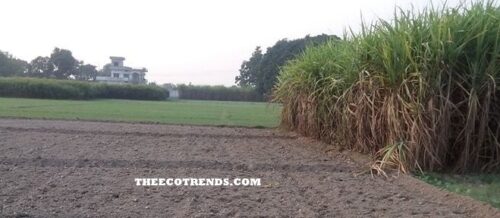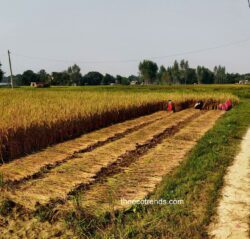The process of recovering or reusing usable materials from discarded waste is called recycling. For example, about 15 per cent of Sulphuric acid is recycled in chemical manufacturing. In the early days, all the sulphur needed for the production of sulphuric acid was taken out of mines directly. But now, with the prevailing tendencies of recycling, sulphuric acid manufacturing industries are using sulphur from smelters, refineries, etc.
Recycling is the process of recovery of used matter for further use through different methods like shredding, Magnetic Separation of metals, air classification, Screening, washing etc. Bottles, cans, newspapers, cardboard, and other items are recycled today to minimize waste. This process lessens the load at incinerators and landfills.
Wood is a versatile material and can be used in varieties of ways. When wood products or timber reaches to the end of its first life in a building or other use, it ends up being re-used or re-cycled, burnt for fire making or removed to waste. A much better and environment-friendly option is recycling of wood or timber.
Timber recycling or Wood recycling is the process of turning waste timber into new and usable timber. The practice of recycling timber was popularized during the early 1990s when the issue of deforestation and climate change emerged and came to be recognised as global problems threatening lives on this planet. The emerging issue of deforestation leading to another issue of climate change climate prompted timber- suppliers, consumers, and governments to turn towards more sustainable sources of timber. Recycling of timber is the most environmentally friendly form of timber production. Timber can also be chipped down into wood chips which can be used to power homes or power plants.
Paper Industry
Though per capita paper consumption in India is very low as compared to other countries of the world, the paper Industry holds a considerable share in manufacturing production. The paper industry in India is more than a century old and at present, there are over 600 paper mills manufacturing a wide variety of items required by the consumers. These paper mills produce a variety of different types of paper including paper boards and newsprint products. The shares of different types of paper in the area of production has been reported to be – 41% for cultural paper, 27% crafts paper, 17% for paperboard, 12% for newsprint, and 3% for speciality paper.
On the basis of the consumption of raw material, the Indian paper industry can be classified into three basic categories – Wood-based, agro-based & Waste paper-based paper industries. About 2o are wood-based paper industries while 580 are based on non-conventional raw materials.
The paper industry has acquired a prominent place in discussions about the local and global environment as it has become one of the energy-intensive and highly polluting industries. Through the adoption of more efficient and cleaner technology in the paper manufacturing sector objectives of economic, environmental, and social developments can be achieved without causing considerable damage.
The Pulp and Paper Industry is a chemical process industry that has a major impact on the environment.
The production and use of paper have a number of bad impacts on the environment. These bad impacts are collectively known as Paper Pollution. The pollutants that emerge out of pulp and paper mills are- liquid effluents, air pollutants, solid waste, and noise pollution. The pollution from the paper industry has been categorized as air pollution, water pollution and land pollution.
The paper industry emits oxides of nitrogen like nitrogen dioxide; Sulphur dioxide, and Carbon dioxide during the paper manufacturing process adding to air pollution. Nitrogen dioxide and Sulphur dioxide are major contributors to acid rain where as Carbon dioxide is a greenhouse gas and contributes to global warming and climate change. Additional hazards are produced by paper industries due to toxic chemicals, dyes and polymers that are potentially carcinogenic on incineration.
Paper industries produce wastewater which contains particles, nutrients, and discarded organic matter like lignin. It also contains alcohols and chelating like chlorates and transition metal compounds. The wastewater from the paper industry contains nutrients like Nitrogen and Phosphorus that cause the eutrophication of freshwater bodies like ponds and lakes. Eutrophication can change the ecological characteristics of water which can lead to deaths of even higher life forms. The wastewater from the paper industry may contain Organochlorine- compounds. The chlorine bleaching of pulp produces it in larger amounts. The sludge produced during the removal of ink from printed waste paper is also a source of water pollution.
Discarded paper is a major land pollutant which accounts for about 35% by weight of municipal solid waste. It is a major component of landfill sites. The amount of paper and paper products is enormous; hence the environmental impact is also very significant. It is estimated that by 2020 paper mills will produce about 500, 000 tons of paper and paperboard per year. So, great efforts are needed to ensure that the environment is protected during the process of paper production, paper use, recycling or disposal of the enormous volume of waste produced by the paper industry.
The pulp and Paper Industry is considered as 5th largest consumer of energy. It accounts for 4% of all the energy use of the world. This industry uses more water per ton of paper production than any other industry.
As per reports, worldwide consumption has risen by 400% in the past 40 years with 35% of harvested trees being used by the paper industry. Logging of old-grown forests accounts for less than 10 of wood pulp but it is one of the most controversial issues today. The majority of wood today is obtained from plantation forests which is a monoculture and raises concern over the ecological effects of the practice.




